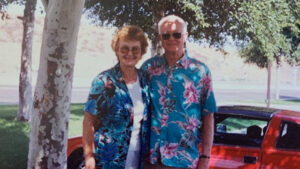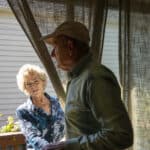
In this photo, taken in the summer of 1994, Robert and Corinne Patrick were happy and enjoying life in Atascadero, Calif. They lived in a nice home, and their 2 ½ acre lot was brimming with fruit and walnut trees. Robert, or Bob, as he’s called, a retired computer engineer, made improvements to the landscaping and Corinne often spent time harvesting the fruit.
Several years after the photo was taken, it was a fall while picking plums which signified that the Patricks’ lives were heading for a change. Corinne, then 75, rolled her foot and broke her hip. Her recovery was slow and she had to temporarily use a wheelchair.
Not long after that, Bob began harboring concerns about Corinne’s memory.
“Her mother died of Alzheimer’s, so did a sister, and another sister was showing symptoms,” said Bob, now 90 and living in Santa Maria, Calif. “Corinne wasn’t very concerned about herself, but she was getting forgetful. She didn’t want to cook anymore. And one time, she got lost in our small town and I had to go and pick her up.”
Without a family support system nearby (Corinne had family in Minnesota as well as Arizona, where her son lived), Bob thought it would be best for them to move into a retirement community, which is how they landed in Santa Maria about four years ago.
Even the move was fraught with red flags; Corinne was still driving at the time, and her car was part of a caravan of four loaded vehicles heading for Santa Maria from Atascadero when Bob realized something was wrong.
“When I stopped to check the lashings on my trailer load, there were only three vehicles. She was missing. I had no choice but to continue and unload,” he said. “I drove frantically back to our old home. There she was sitting in her car in the driveway of an empty house.
“She had gotten confused and left our caravan at a freeway exit she recognized and went back home. Nothing hurt, just a mountain of concern.”
From there, the couple’s journey into Alzheimer’s began proceeding at a more pronounced pace. As Bob recalled, it became his task to become better informed about the disease and he spent a lot of time reading journals, reports and magazines. He read “Still Alice” by Lisa Genova, the story of a linguistics professor facing early-onset Alzheimer’s disease, as well as “The 36-Hour Day,” a dementia-care guide by Nancy L. Mace and Peter V.Rabins. (“You get pretty smart that way, but the reading isn’t very pleasing.”)
He also navigated various channels to find the right doctor for Corinne.
A Full-time Caregiver
“We saw a doctor in Santa Barbara. I sat in the back of the room while he asked Corinne some questions. They were the same ones I’d read about in some study, out of Ohio,” Bob said. “He was very careful about his diagnosis. He told me she was failing, and to come back in six months, but he didn’t name what was going on as Alzheimer’s.”
“He was careful not to say too much, but instead he said too little,” Bob added.
After Corinne suffered a second fall, this time off a patio step, and began to grow weaker, Bob became her full-time caregiver.
While Corinne had always handled the housework, taxes and other miscellaneous home chores, and Bob had been in charge of yard maintenance, he realized that divided responsibilities had put him at a disadvantage.
“As you age, I suggest you dissolve your rigid assignments and work together more. I abruptly became a caregiver. At the same time, I had to learn how to do her chores,” he said. “It took me three months to reliably fry an over-easy egg without breaking the yolk.”
Grateful for Help
In Santa Maria, Bob was grateful to find a gerontologist to serve as his doctor (he had a pacemaker installed and suffered two small strokes) who counseled him to seek daily help for Corinne, and pointed him in the direction of a home health care company.
“It was so helpful. Someone came two hours each day so I could go out and do errands. They would give her baths, wash her clothes and then I’d put them in the dryer when I got back,” he said.
Corinne had reached the point where, Bob said, “she couldn’t get out of bed by herself, slept poorly, cried easily and lived in the present, with very little memory of their life together.”
The presence of the home care workers made a big difference. When asked if he ever attended caregiving support groups, Bob said he went once.
“It was a bust. It didn’t help,” he said. “I felt isolated.”
After Corinne had another fall and ongoing struggles with her incontinence, Bob realized he could no longer manage his wife’s care at their home. A first nursing home move wasn’t a good fit. Based on the recommendation of a trusted neighbor, in early 2019, Bob found a small care home where Corinne lived peacefully until her death from a heart attack in July 2020 at 92.
“There were four people, plus her. A family took care of them,” he explained, adding that since the home was so small, his every-other-day visits were not restricted due to COVID-19. “Even with her limited abilities, she got to know other people. She liked it. It was quieter there.”
Looking back, Bob said, he feels like “her final days lasted seven months” as his wife slowly withdrew. He discovered some ways to keep her engaged as much as possible during his visits.
“I would bring packets of photos to show her. We had some pictures of the Granny Smith apple trees we’d grown on our ranch. One year, we picked four-thousand pounds of apples and loaded them into the back of our truck and took them to a food bank,” Bob recalled.
Corinne enjoyed single-subject photos like that, but as Bob said, “the initiative was all mine” when it came to conversation.
He’d mostly sit by her side and hold her hand. He said she always knew who he was.
There was one pleasure that remained for Corinne until the end of her life.
“She loved Hershey’s kisses. I’d bring pocketfuls with me when I visited so everyone there could have some chocolate candy,” Bob said.
About six months before Corinne died, Bob started compiling what he calls “A Caregiver’s Diary,” which is approximately 23 pages. In it, he tells the story of how he and his wife met, where they traveled and about the homes they lived in over the years.
He also documents his wife’s ongoing health challenges and how he learned about everything from long-term care insurance (which he was glad to have purchased about 20 years ago) to medications. Several of the page breaks contain the line, “Alzheimer’s is a terrible disease.”
“I have been a writer all my life. I wrote for a computer programming magazine for twenty-five years,” he said. “The first draft of this booklet tookme about four months. I printed fifty copies and gave them to people for feedback.” He said it was helpful for him to write the story of their life together.
Bob and Corinne were married for 65 years. Since her death, without the responsibility and attention he paid to her as a caregiver, Bob’s life has profoundly changed.
When asked to offer some thoughts about that, he paused before saying, “That’s a question I just can’t answer.”
(If you would like to read Bob Patrick’s complete caregiving guide, email him at bobpatrick@me.com.)
©Next Avenue. Julie Pfitzinger is the editor for Next Avenue’s lifestyle coverage across the Living and Technology channels. This article was originally published by nextavenue.org.







